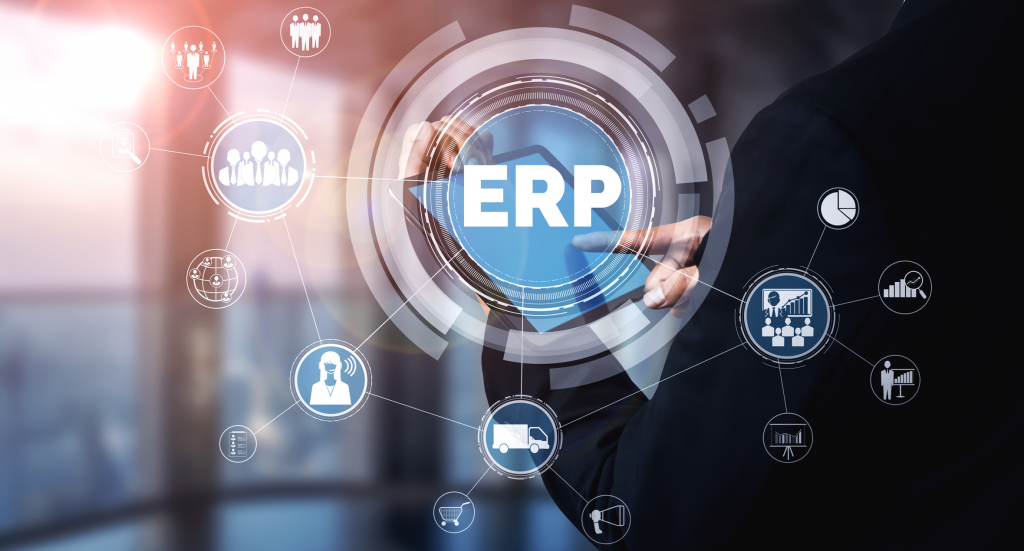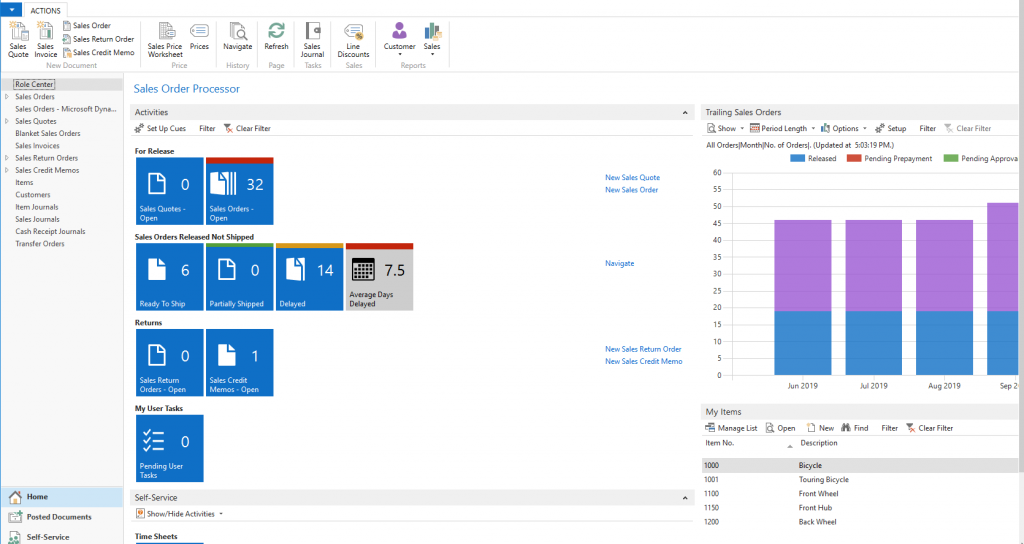Microsoft Dynamics 365 and Dynamics 365 Business Central are both business management solutions offered by Microsoft, designed to help companies manage their operations more efficiently. In this blog series, we continue our exploration of Microsoft Dynamics 365, focusing today on the specifics of Dynamics 365 Business Central.
What is Microsoft Dynamics 365 Business Central
Dynamics 365 Business Central is a cloud-based ERP solution specifically designed for small and medium-sized businesses (SMBs). The original name of the product before it was renamed Business Central was Dynamics NAV. The key difference is that Dynamics NAV operates directly on-site and is installed on local servers. Dynamics 365 Business Central is built on top of Dynamics NAV, it provides improved usability, cloud accessibility, and a more comprehensive feature set.
It offers comprehensive functionalities to manage finances, sales, purchasing, inventory, projects, and more, all within a single platform.
Business Central could be seamless integrated with other Microsoft applications like Office 365, Power BI, and Microsoft 365.
Advantages of Business Central
Dynamics 365 Business Central continues to gain popularity, especially among small and medium-sized businesses seeking streamlined ERP capabilities.
Affordability: Cost-effective solution tailored for the budget and needs of SMBs.
Ease of Use: Intuitive user interface designed for non-technical users, with minimal training required.
Rapid Implementation: Quick deployment and setup compared to traditional on-premises ERP systems.
Scalability: Can grow with the business, accommodating increasing data volumes and users.
Cloud-based: Offers the flexibility of accessing data and applications from anywhere, anytime.
Differences Between Microsoft Dynamics 365 and Business Central
The most frequently asked question is what is the difference between Dynamics 365 and Business Central?
Above we have already talked about the basic characteristics of Business Central. Let’s compare the main differences between these two business systems.
What is Microsoft Dynamics 365?
Microsoft Dynamics 365 is a suite of cloud-based business applications that integrate customer relationship management (CRM) and enterprise resource planning (ERP) capabilities. It encompasses various solutions to address the diverse needs of organizations.
Target Audience
Dynamics 365 is suitable for businesses of all sizes, while Business Central is specifically targeted at SMBs.
Scope
Dynamics 365 offers a broader range of functionalities and modules, including CRM capabilities, while Business Central focuses primarily on ERP functionalities.
Complexity
Dynamics 365 may be more complex due to its extensive feature set and customization options, whereas Business Central is simpler and easier to implement, especially for smaller organizations.
Cost
Dynamics 365 may involve higher licensing and implementation costs, whereas Business Central is typically more affordable, with subscription-based pricing tailored for SMBs.
Both Microsoft Dynamics 365 and Business Central are powerful business solutions, the choice between them depends on the size, complexity, and specific needs of the business. Large enterprises with complex requirements may opt for Dynamics 365, while SMBs looking for a more streamlined and cost-effective solution may prefer Business Central.
Dynamics 365 Business Central Integration
Organizations that use Dynamics 365 Business Central often integrate it with various systems and applications to enhance their business processes.
Integrating Dynamics 365 Business Central with other business applications instead of relying solely on the broader Dynamics 365 suite can be influenced by several factors.
Let’s explore some common integration scenarios and reasons why companies make this choice:
Dynamics 365 Business Central and E-Commerce Integration
Integration Purpose: Connecting Business Central with e-commerce platforms (such as Shopify, BigCommerce, Magento or Amazon) allows seamless synchronization of product catalogs, inventory levels, orders, and customer data.
Why?: By integrating e-commerce systems, businesses can automate order processing, maintain accurate stock levels, and provide real-time information to customers.
Business Central and Electronic Data Interchange (EDI) Integration
Integration Purpose: EDI integration enables the exchange of business documents (such as purchase orders, invoices, and shipping notices) electronically between Business Central and trading partners.
Why?: EDI streamlines communication, reduces manual data entry, and ensures data accuracy in business transactions.
Business Central and Customer Relationship Management (CRM) Software Integration
Many companies have existing systems, such as CRM platforms like Salesforce, or other specialized tools. These systems may already be deeply integrated into their processes. Migrating everything to a new system can be disruptive and costly.
Integration Purpose: Linking Business Central with CRM systems (like Microsoft Dynamics 365 Sales or Salesforce) ensures a unified view of customer interactions, sales opportunities, and order history.
Why?: Seamless CRM integration enhances customer service, sales forecasting, and personalized marketing efforts.

Business Central Integration with Business Intelligence and Analytics Tools
Integration Purpose: Integrating with tools like Power BI or Tableau allows organizations to analyze data from Business Central, create dashboards, and gain insights into financial performance, inventory trends, and operational efficiency.
Why?: Data-driven decision-making becomes more effective when integrated with robust analytics platforms.
Business Central Integration with Financial Services
Integration Purpose: Connecting Business Central with financial services (such as payment gateways, credit card processors, or banking systems) streamlines payment processing, reconciliation, and financial reporting.
Why?: Efficient financial operations are critical for any business, and fintech integrations enhance accuracy and speed.
While Dynamics 365 offers a comprehensive suite, licensing costs can add up. Integrating Business Central with existing systems and applications allows companies to optimize costs by paying only for necessary features.
Outsourcing Integration Services
Many companies realize the importance of integrating their systems and applications. However, not every company can afford to maintain its own team of specialists exclusively for integration projects. This is why we, at EDI2XML offer our integration services.
Our Expertise, Your Advantage
Turnkey Solutions:
We offer end-to-end integration services—from planning to post-implementation support. You don’t need to worry about assembling a team or managing the intricacies of integration projects. We handle it all.
Customized Approach
Every business is unique. Our experienced professionals tailor integration solutions to your specific needs. Whether it’s connecting Dynamics 365 Business Central with your existing CRM, e-commerce platform, or financial system, we’ve got you covered.
Cost-Effective Strategy
Outsourcing integration eliminates the need for full-time specialists. You invest in the expertise required, ensuring you’re only paying for the specific knowledge and skills essential for your current objectives and challenges. No overhead costs, no idle resources.
Seamless Transition
Worried about disruptions during implementation? Don’t be. Our seamless transition ensures minimal impact on your daily operations. We work behind the scenes, so you can focus on what matters most.
Scalability and Flexibility
As your business grows, so do your integration needs. We scale our services accordingly. Plus, with cloud-based solutions like Business Central, you’re ready for future expansion.
Your Success, Our Mission By partnering with us, you gain access to a dedicated team of integration experts who understand the intricacies of Dynamics 365 Business Central and beyond. Let us handle the technical details while you stay focused on driving your business forward. Book a free consultation with our integration expert!






